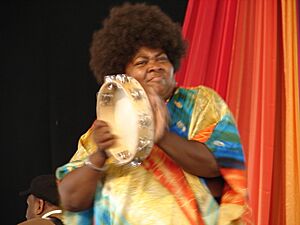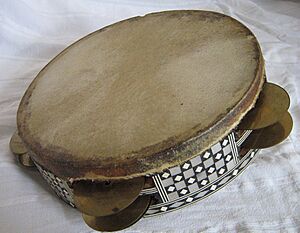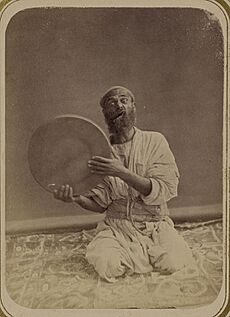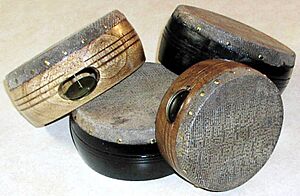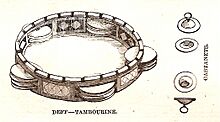Tambourine facts for kids
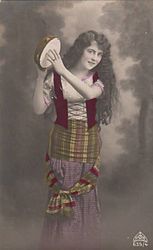
A Gypsy girl with tambourine (postcard from around 1910)
|
|
| Percussion instrument | |
|---|---|
| Other names | Riq, Buben |
| Classification | Hand percussion |
| Hornbostel–Sachs classification | 112.122(+211.311, with drumhead) (Indirectly struck idiophone, sometimes including struck membranophone) |
| Related instruments | |
| Riq, Buben, Dayereh, Daf, Kanjira, Frame drum | |
The tambourine is a fun musical instrument that belongs to the percussion family. This means you play it by hitting, shaking, or scraping it. It usually has a round frame, often made of wood or plastic.
Attached to the frame are small pairs of metal jingles, called "zills." Many tambourines also have a drumhead (a skin stretched over the frame), but some do not. You can hold a tambourine in your hand and tap, hit, or shake it. You can also mount it on a stand, like with a drum kit, and play it with drum sticks.
Tambourines come in many shapes, but the most common is circular. You can find them in many types of music, including folk music from different countries, classical music, samba, gospel music, pop music, country music, and rock music.
Contents
History of the Tambourine
We don't know exactly when the tambourine was invented. But we do know it was used by ancient musicians as early as 1700 BC. It first appeared in Ancient Egypt and the Ancient Near East. Later, it traveled to Greece and other places.
Merchants or musicians helped bring the tambourine to Europe. In ancient Egypt, it was called the tof by the Hebrews, who mostly used it in religious ceremonies. The word tambourine comes from the French word tambourin. This word referred to a long, narrow drum used in Provence, France. It's a smaller version of tambour, which means "drum."
How to Play the Tambourine
You can hold the tambourine in your hand or put it on a stand. There are many ways to play it! You can gently stroke or shake the jingles. You can also hit it sharply with your hand or a stick. Some players even use the tambourine to hit their leg or hip to make sounds.
Tambourine Rolls
A "tambourine roll" is a fast, continuous sound from the jingles. The easiest way to do this is to quickly twist the hand holding the tambourine back and forth. You pivot your wrist to make the jingles shake rapidly.
Thumb Roll
An advanced way to make a roll is called the thumb or finger roll. You move your middle finger or thumb over the skin or rim of the tambourine. This makes a fast, buzzing sound from the jingles. You press your thumb or finger against the head, about one centimeter from the edge. If you do it right, your finger will bounce quickly, creating the roll.
To help with this, players often put Beeswax or rosin around the edges of the drumhead. These materials make it easier for your finger to grip and bounce. You can make a continuous roll by moving your thumb in a figure-eight shape around the head.
Tambourine in Popular Music
Europe
The tambourine is part of many European folk music traditions. The Romani people often used the tambourine as a percussion instrument. They would sometimes pass it around the audience to collect money after a show. In the late 1700s, the tambourine became very popular in England. Some composers even wrote music specifically for it, with up to 30 different ways to play it!
Tambourines from this time often had a hole for the thumb. This was for a trick where players would spin the tambourine on their upright thumb. In the late 1800s, The Salvation Army made the tambourine one of their main rhythm instruments. They called it a "timbrel," a name from the Bible. By 1945, Salvation Army shows sometimes had fancy tambourine dances. These were done by groups in a military-like style, more for show than for just music.
African American Influence
When African American slaves were not allowed to have drums (which could be used for sending messages), they found other ways to make rhythm. They used smaller instruments like bones and the tambourine. They also used clapping and body percussion. The tambourine was used to go along with spirituals (religious songs). It was also used for celebrations and dancing.
The tambourine became a main instrument in American minstrel shows in the early 1800s. These shows often featured white performers in blackface, like Ned Christy. Sometimes, black performers also played. In minstrel shows, the tambourine and bones players stood at the ends of the stage. They were called Brother Tambo and Brother Bones.
The tambourine was also used in some vaudeville acts. For example, in the 1840s, a dancer and musician named Master Juba could make many different sounds from the tambourine. He could even make it sound like a steam train! By the 1920s, the tambourine was the main percussion instrument in gospel music. Gospel groups and choirs used it. Singers who didn't play other instruments, like Bessie Jones and Luther Magby, often carried it.
The tambourine then moved from gospel music into other types of African American popular music, like blues and jazz. For example, the singer and guitarist Blind Roosevelt Graves was joined by his brother Uaroy, who played tambourine and sang. Singer-songwriter Josh White started as a child, performing for money on the street. He played the tambourine with lots of energy, hitting it on his elbows, knees, and head.
In the 1950s, gospel sounds were added to rhythm and blues by singers like Ray Charles. The tambourine often came along with these changes. It continued to be popular in the music of Motown. Many Motown singers and musicians grew up with gospel music. They brought the tambourine into pop performances. The Supremes performed with two tambourines. These were played by Florence Ballard and Mary Wilson, who stood apart from Diana Ross. Jack Ashford's special tambourine playing was a big part of the rhythm section on many Motown songs. Examples include the Miracles' "Going to a Go-Go" and Marvin Gaye's "How Sweet It Is."

Inspired by African American musicians, performers of all backgrounds have used the tambourine in modern pop music. It was featured in "Green Tambourine," a song about street performers by the Lemon Pipers, a white American band from the 1960s. Also, the Byrds had a hit song in 1965 with "Mr. Tambourine Man," written by Bob Dylan. The tambourine in this song helps to keep the beat moving forward.
Singers who don't usually play an instrument often play the tambourine at concerts. Famous examples include Mick Jagger of the Rolling Stones, Jim Morrison of The Doors, Janis Joplin with Big Brother and the Holding Company, and Stevie Nicks from Fleetwood Mac. Often, the instrument used in pop music is a headless tambourine or "jingle ring," which doesn't have a drum head.
A good singer knows how to play the tambourine to fit the song. Sometimes, band members have even hidden the tambourine from a singer who played it too much! But skilled performers like Mick Jagger have used the tambourine with great timing. In the Rolling Stones' 1964 song "Time Is on My Side," Jagger plays the tambourine slightly ahead of the beat. Meanwhile, Charlie Watts plays the snare drum slightly behind the beat. This makes the tambourine's longer sound match the snare at the end, creating a feeling of rushing to catch up.
In jazz, the tambourine was used in unique ways by percussionist Joe Texidor with Rahsaan Roland Kirk in 1969. In 1960, when Nina Simone wanted to play the old song "Li'l Liza Jane" at the Newport Jazz Festival, she asked, "Where's my tambourine?" Jazz drummer Herlin Riley often starts his performances by beating and shaking a tambourine. He also plays the tambourine in Wynton Marsalis's jazz story Blood on the Fields, which is about slavery in the US.
Jazz, pop, and rock drummers sometimes put a headless tambourine on their drum kit. Some place it above the tom drums, like a cymbal. Examples include Nathan Followill of Kings of Leon and Larry Mullen Jr of U2. Bill Ward of Black Sabbath even connected a tambourine to a foot pedal. This allowed him to play it with his left foot, like a hi-hat. John Bonham of Led Zeppelin simply put a tambourine above his hi-hat for extra sound. The Subdudes, a rock group from New Orleans, even had a dedicated tambourine player, Steve Amedée, instead of a drummer.
Tambourine in Classical Music
Wolfgang Amadeus Mozart was one of the first Western composers to include the tambourine in his music. Since the late 1700s, it has become more common in orchestra music. For example, it's used in some of Pyotr Ilyich Tchaikovsky's dance pieces from the Nutcracker Suite. Gustav Holst's seven-part orchestra piece The Planets also features the tambourine in several sections, especially in the "Jupiter" movement. Georges Bizet's Carmen opera includes the famous "Habanera" song, which has tambourine hits in each chorus.
Similar Instruments
Buben
The buben is a musical instrument from the percussion family. It is very similar to a tambourine. A buben has a wooden or metal hoop, often with a tight skin stretched over one side. Some bubens don't have a skin at all. Many bubens have metal rings, plates, cymbals, or small bells that jingle.
You hold it in your hand and can play it in many ways. You can stroke or shake the jingles, or hit it sharply with your hand. It is used to add rhythm to dances, or to go along with solo singers or choirs. Bubens are often used by folk and professional bands, as well as orchestras.
The name "buben" is related to old Greek words for "low sound" and "bee." It's also connected to the English word "bee." Bubens have been around for a very long time in many countries, especially in the East. There are many types of bubens, like the def or qaval from Azerbaijan, the doira from Uzbekistan, and the pandero from Spain. In ancient Russia, large drums and military drums were called buben.
Daf
A daf is a large tambourine or a frame drum. It is used in popular and classical music in places like Iran, Azerbaijan, the Arab world, and Turkey. In Turkey, it's called a tef. The daf usually sets the beat and speed of the music. It acts like a conductor in some types of Eastern music.
The Persian poet Rudaki mentioned the daf and the tambourine in his poems. Albanians often use the tambourine (Daf). Women and bridesmaids often play them at weddings to lead the ceremony when the bride walks down the aisle.
Pandeiro
The pandeiro first came from Galicia in Spain or Portugal. Portuguese settlers then brought it to Brazil. It is a hand percussion instrument with a single drumhead and jingles in the frame. It is a very common instrument in traditional Brazilian music.
Panderoa
The Basque pandero is a folk instrument. It is often played with the trikitixa (a Basque accordion) as a duo. Sometimes the players, who perform at festivals or on stage, also sing along. The pandero can also go with the alboka or txistu (other Basque instruments). However, these duos haven't always been the case. In 1923, young people would gather to dance to the sound of just the pandero, with only the player's (a woman's) voice joining in.
Riq
The riq (also spelled riqq or rik) is a type of tambourine. It is used as a traditional instrument in Arabic music. It is an important instrument in both folk and classical music throughout the Arabic-speaking world. These instruments are also widely known as shakers.
Dayereh
A dayereh (or doyra, dojra, dajre, doira, daire) is a medium-sized frame drum with jingles. It is used to go along with popular and classical music in Iran (Persia), the Balkans, and many Central Asian countries. These include Afghanistan, Tajikistan, and Uzbekistan. It is a percussion instrument that is somewhere between a drum and a tambourine.
Kanjira
The kanjira or ganjira is a South Indian frame drum from the tambourine family. It is mostly used in Carnatic music concerts (classical music from South India). It supports the mridangam (another drum). In northern India, where Hindi is spoken, the instrument is called dafli. It is a common instrument in orchestras and solo performances. Nepal also has many types of tambourines, with names like daanf, damphu, hring, and khaijadi.
Tar
Tar is a frame drum with one drumhead. It comes from Turkey but is often played in North Africa and the Middle East.
Timbrel
The timbrel or tabret was the main percussion instrument of the ancient Israelites. It was similar to the modern tambourine. It was known as the tof to the ancient Hebrews, the deff in Islam, and the adufe to the Moors of Spain.
Rabana
A rabana (plural raban) is a traditional tambourine from Sri Lanka. It has only one side and is played with the hands.
Rebana
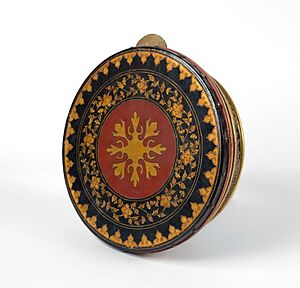
The rebana is a Malay tambourine. It is used in Islamic religious music in Southeast Asia. You can find it especially in Indonesia, Malaysia, Brunei, and Singapore.
See also
 In Spanish: Pandereta para niños
In Spanish: Pandereta para niños
Images for kids




